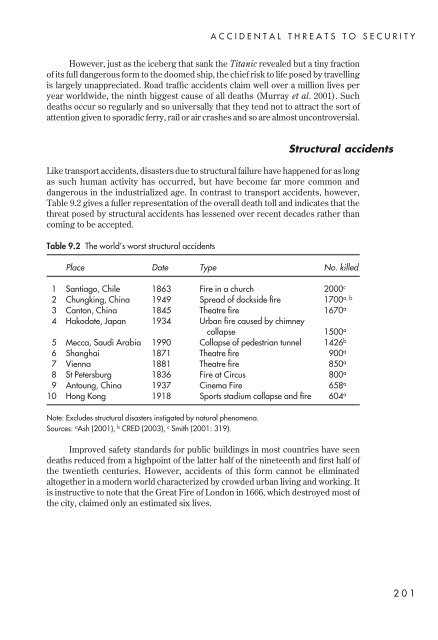Understanding global security - Peter Hough
Understanding global security - Peter Hough
Understanding global security - Peter Hough
Create successful ePaper yourself
Turn your PDF publications into a flip-book with our unique Google optimized e-Paper software.
ACCIDENTAL THREATS TO SECURITY<br />
However, just as the iceberg that sank the Titanic revealed but a tiny fraction<br />
of its full dangerous form to the doomed ship, the chief risk to life posed by travelling<br />
is largely unappreciated. Road traffic accidents claim well over a million lives per<br />
year worldwide, the ninth biggest cause of all deaths (Murray et al. 2001). Such<br />
deaths occur so regularly and so universally that they tend not to attract the sort of<br />
attention given to sporadic ferry, rail or air crashes and so are almost uncontroversial.<br />
Structural accidents<br />
Like transport accidents, disasters due to structural failure have happened for as long<br />
as such human activity has occurred, but have become far more common and<br />
dangerous in the industrialized age. In contrast to transport accidents, however,<br />
Table 9.2 gives a fuller representation of the overall death toll and indicates that the<br />
threat posed by structural accidents has lessened over recent decades rather than<br />
coming to be accepted.<br />
Table 9.2 The world’s worst structural accidents<br />
Place Date Type No. killed<br />
1 Santiago, Chile 1863 Fire in a church 2000 c<br />
2 Chungking, China1949 Spread of dockside fire 1700 a, b<br />
3 Canton, China 1845 Theatre fire 1670 a<br />
4 Hakodate, Japan 1934 Urban fire caused by chimney<br />
collapse<br />
1500 a<br />
5 Mecca, Saudi Arabia 1990 Collapse of pedestrian tunnel 1426 b<br />
6 Shanghai 1871 Theatre fire 900 a<br />
7 Vienna1881 Theatre fire 850 a<br />
8 St <strong>Peter</strong>sburg 1836 Fire at Circus 800 a<br />
9 Antoung, China1937 CinemaFire 658 a<br />
10 Hong Kong 1918 Sports stadium collapse and fire 604 a<br />
Note: Excludes structural disasters instigated by natural phenomena.<br />
Sources: a Ash (2001), b CRED (2003), c Smith (2001: 319).<br />
Improved safety standards for public buildings in most countries have seen<br />
deaths reduced from a highpoint of the latter half of the nineteenth and first half of<br />
the twentieth centuries. However, accidents of this form cannot be eliminated<br />
altogether in a modern world characterized by crowded urban living and working. It<br />
is instructive to note that the Great Fire of London in 1666, which destroyed most of<br />
the city, claimed only an estimated six lives.<br />
201
















